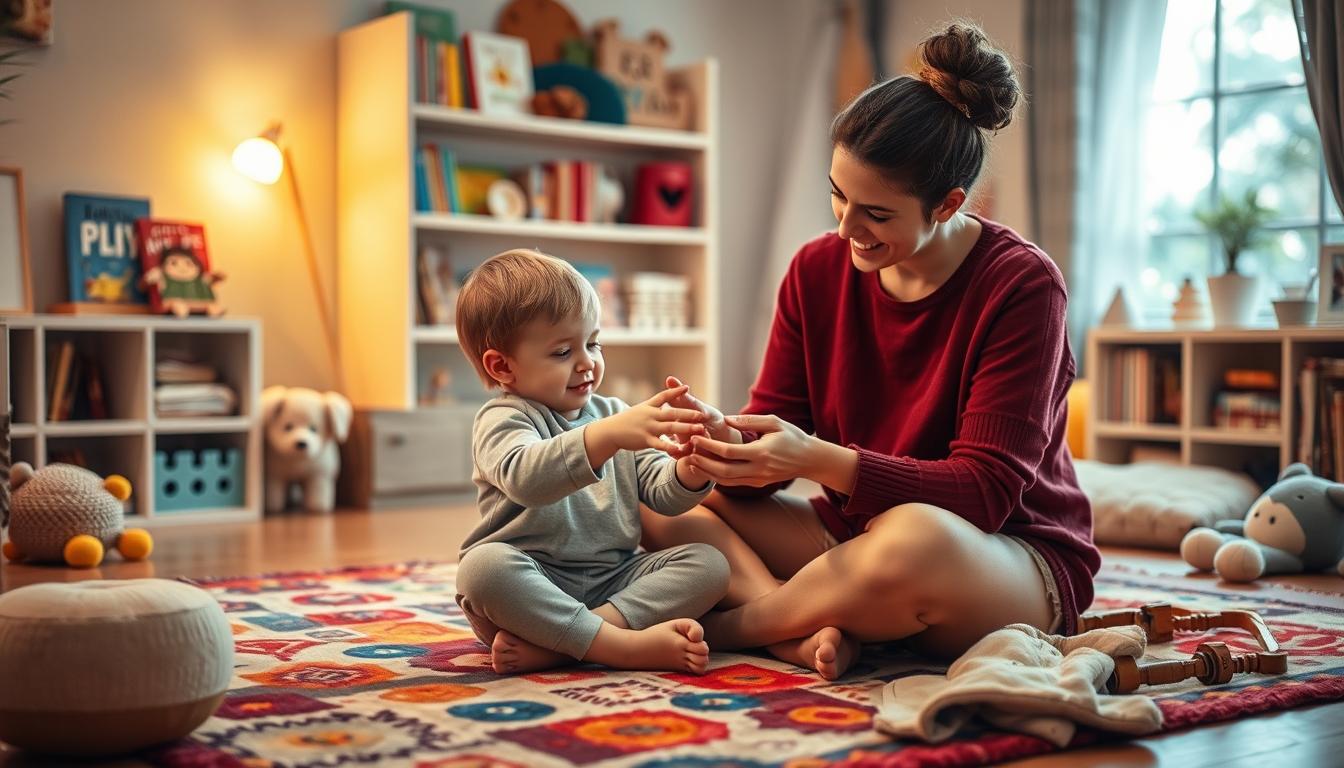Have you ever wondered why some children avoid eye contact, while it seems so natural for others?
Eye contact is key for good communication. It shows we’re paying attention and care about what the other person is saying. But, some kids have trouble with eye contact. This might be because of autism, hearing issues, or feeling anxious.
It’s important not to force eye contact. This can make a child feel even more stressed. Instead, we should focus on making them feel comfortable and use strategies that help.
Key Takeaways
- Effective communication heavily relies on eye contact in social interactions.
- Challenges with eye contact can indicate conditions like autism spectrum disorder or social anxiety.
- Directing children to engage in their favorite subjects can encourage more natural eye contact.
- Modeling appropriate eye contact can help children learn by example.
- Professional help may be necessary for children with significant eye contact issues impacting their well-being.
Understanding the Importance of Eye Contact
Eye contact is key in good communication. It makes the speaker feel heard and valued. It’s one of the first things babies and toddlers learn, along with sounds and body language.
When you look at someone while talking, it shows respect and interest. This builds trust in our interactions with others.
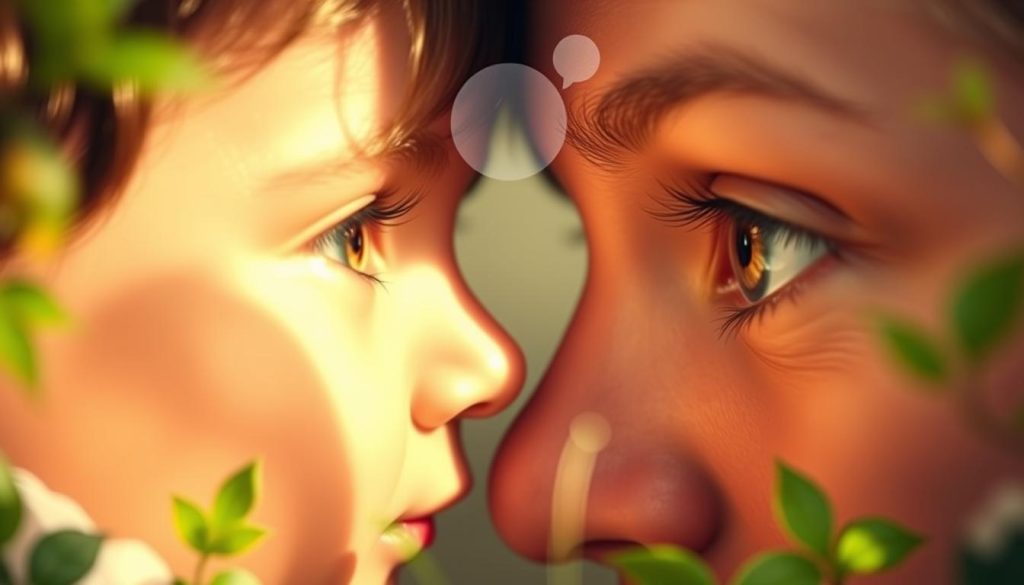
The Role of Eye Contact in Effective Communication
Eye contact sends emotional messages and social signals. It’s vital for making and keeping connections. When you look at someone, you show you’re paying attention.
This helps build confidence, especially in young children. It’s also important for leaders to be good at eye contact. It makes expressing feelings and ideas clearer, especially in disagreements.
Social Cues and Emotional Awareness
Eye contact is essential for understanding social cues. It helps create emotional bonds, positivity, and empathy. These are key for growing socially.
For young kids, practicing eye contact boosts their social and expressive abilities. They can get better at it by mirroring others or focusing on faces.
Challenges with Eye Contact in Autism and Other Conditions
For kids with autism or other neurological issues, eye contact can be very hard. It can cause stress and affect their social skills. It’s important to understand and support each child’s needs.
Family support and controlling screen time are also key. Using comfort items or practicing with a mirror can help too.
Reasons Why Some Children Avoid Eye Contact
There are many reasons why some kids don’t like to look people in the eye. Things like Autism Spectrum Disorder (ASD) and feeling shy can make it hard for them. Also, what they learn from their culture, any health issues, and how they feel can affect it too.
Autism Spectrum Disorder and Eye Contact
One sign of Autism Spectrum Disorder is trouble keeping eye contact. Kids with autism might find it too much because they are very sensitive to sounds and sights. This makes them uncomfortable and they try to avoid eye contact.
If your child has trouble with eye contact, it’s a good idea to check if they might have autism. This way, you can understand what’s going on and help them.
Social Anxiety and Eye Contact Avoidance
Social anxiety is another big reason kids might not want to look people in the eye. Feeling bad about themselves or being scared of what others think can make them shy away. This is especially true for middle children, who might feel left out and anxious.
Online family therapy can be a big help. It can give kids the support they need to feel more confident when talking to others.
Other Factors Affecting Eye Contact
Other things can also make it hard for kids to keep eye contact. For example, if they have trouble hearing, they might struggle to follow conversations. Also, kids who go through their parents’ divorce might feel stressed and avoid eye contact during tough talks.
Children with ADHD or ADD might find it hard to focus on someone’s face. Some kids might look at the mouth instead to understand what’s being said. Programs and talks about growing up can help them understand and improve their social skills.
Parenting Challenges Related to Eye Contact
Teaching kids to make eye contact can be tough. Your usual ways of teaching manners might not work when kids avoid eye contact to feel safe. It’s key to understand this to find better ways to parent.
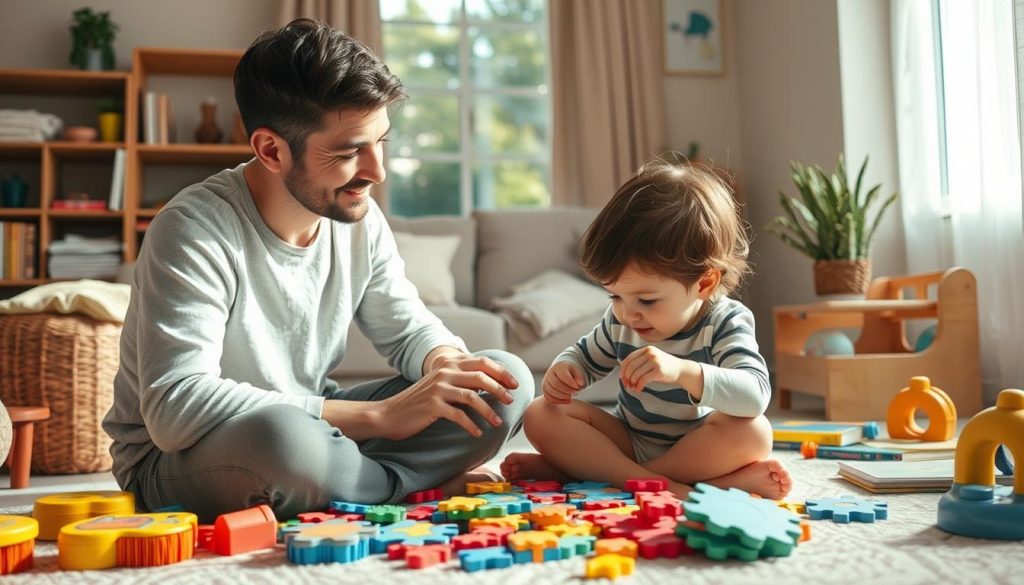
About 80% of kids might look away to avoid feeling stressed. This is especially true for kids with autism who feel overwhelmed easily. Pressuring them to look at you can make things worse, as 60% of parents have found.
Using *gentle parenting* and respecting your child’s likes can help. Doing fun activities together, like bouncing a ball, can help you talk better. This way, you teach them about consent and make conversations more open.
Handling eye contact issues is more than just gentle parenting. It’s also about knowing when to give space, especially in tough situations like *sibling rivalry*. It’s important to understand when to use other ways of showing you’re listening, like looking at their face.
Remember, how you feel about eye contact matters too, especially when dealing with *postpartum mental health*. Being ready emotionally can change how you connect with your child. This caring approach can lead to better ways of talking and understanding each other.
Strategies to Support a Child with Eye Contact Struggles
Helping a child with eye contact issues is a delicate task. But with consistent effort, positive changes can happen. Here are some strategies to help your child improve their eye contact skills:
Reinforcing Naturally Occurring Eye Contact
Watching for natural eye contact moments is key. Research shows kids who look at adults when given instructions are more likely to follow them. Praise and rewards can encourage more eye contact. This fits well with eco-friendly parenting that focuses on positive reinforcement.
Engaging in Conversations About Favorite Subjects
It’s hard to talk to kids about drugs or other serious topics if they’re not interested. But, discussing their favorite subjects can help. Studies indicate that kids under 2 who make more eye contact have better language skills. When they’re excited about a topic, they’re more likely to keep eye contact.
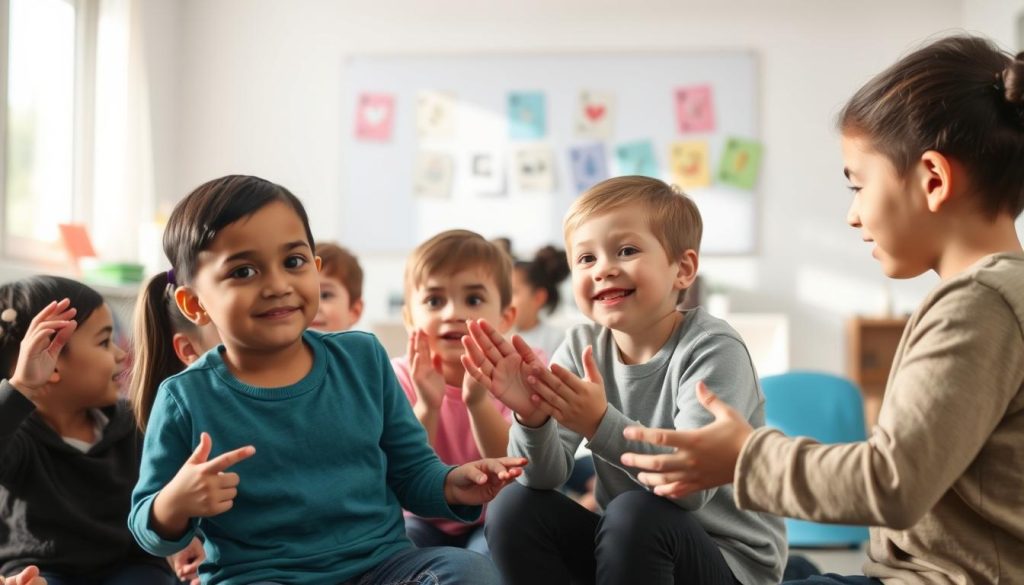
Modeling Appropriate Eye Contact
As a parent or caregiver, showing good eye contact is important. Kids learn by watching, so always make eye contact when you talk to them. This is especially helpful in sports, where eye contact is key for team communication.
Using Positive Reinforcement
Positive reinforcement can help improve eye contact gradually. Break down the skill into small steps, like glancing briefly or holding a gaze. Consistent encouragement is crucial. This method can be part of alternative communication strategies for kids with challenges.
If these strategies seem too much, talk to a professional. They can offer tailored support for kids with specific needs, like those with ADHD or screen time issues. Customized help can lead to lasting improvements in eye contact and social skills.
Alternative Approaches When Eye Contact Is Too Challenging
When direct eye contact is hard for a child, there are good ways to connect. Telling kids to look at the nose or mouth can be easier. It helps them feel more comfortable and engaged.
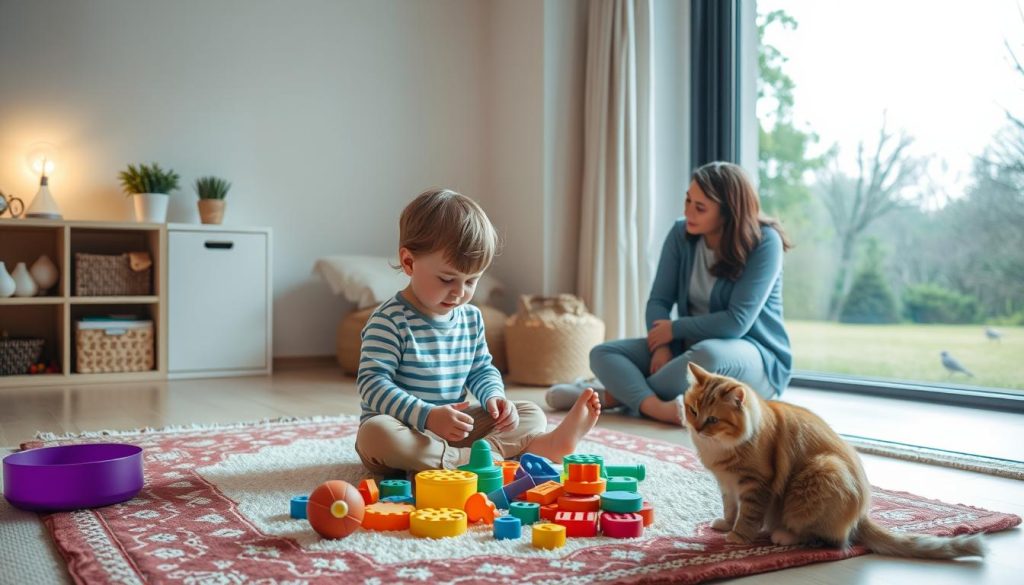
Encouraging Looking at Faces Instead of Eyes
As kids grow, they naturally look at people’s eyes to talk. But some, like those with anxiety or autism, find it hard. Looking at the nose or mouth is a softer way to start socializing. It helps with body positivity for kids.
Providing Comfort Objects and Fidget Tools
Comfort objects and fidget tools make kids feel safe. They’re great for kids who feel stressed, especially when families get remarried. These tools help kids feel more open to interact without feeling forced to look at someone’s eyes.
Utilizing Parallel Play
Parallel play lets kids play next to each other without looking at each other. It’s a way to talk without feeling stressed about eye contact. It’s also a key topic in online family therapy. It helps families adjust to new situations and budgeting.
When to Seek Professional Help
While home strategies can help, sometimes you need professional help. Experts in behavioral therapy and developmental issues can help kids who have trouble with eye contact. They can check if it’s related to autism or social anxiety.
Getting help from professionals means getting therapies and support that fit your child’s needs. Online family therapy offers flexible help, making it easy for families to get the support they need. A family-centered approach builds trust and keeps everyone involved in the treatment.
Childhood mental health includes many disorders like anxiety, ADHD, and childhood eating disorders. Getting help early can stop bigger problems later. Professionals help with immediate issues and plan for the long term.
Coaching kids in sports might not seem related to eye contact, but it shows the value of working with experts. Just as a sports coach helps with physical and social growth, therapists support emotional and social skills. Issues like postpartum mental health can also affect children, making professional support key for the whole family.
Seeking professional help is a positive step for your child’s success. Early help can make a big difference for your child and your family. By getting professional support, you’re helping your child grow emotionally and develop well.
Conclusion
Understanding and supporting a child who struggles with eye contact is key. It requires sensitivity, flexibility, and a willingness to adjust strategies for each child. Gentle parenting helps, but it’s also important to respect the child’s comfort level.
This approach builds strong connections and boosts the child’s confidence. It helps them feel good about themselves.
Family budgeting plays a big role too. Financial stress can affect how we parent and our child’s development. Creating a supportive environment is crucial for their emotional and social growth.
Body positivity for kids is important in this setting. It helps prevent issues like poor impulse control and aggression.
Eco-friendly parenting strategies also help. They create a calm, stable home. This is good for a child’s brain and emotional control, which starts early and grows fast.
Knowing when to seek professional help is vital. This is especially true for issues like autism or social anxiety.
In short, creating a warm, accepting, and positive environment is essential. Using these strategies can greatly help your child’s social and emotional growth. It sets them up for strong relationships in the future.
FAQ
What role does eye contact play in effective communication?
Why is eye contact important for social cues and emotional awareness?
Why do children with autism have challenges with eye contact?
How can social anxiety affect a child’s eye contact?
Are there other factors that affect a child’s ability to make eye contact?
What are some parenting challenges related to children’s eye contact issues?
How can parents gently encourage eye contact in children?
What alternative approaches can help when eye contact is too challenging for a child?
When should parents seek professional help for a child’s eye contact difficulties?
This post contains affiliate links. If you click on a link and make a purchase, I may earn a small commission — at no extra cost to you. Thank you for supporting this blog and helping me keep the patterns free! Read the full Affiliate Disclosure & Transparency.
